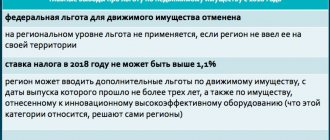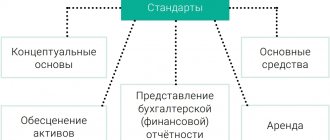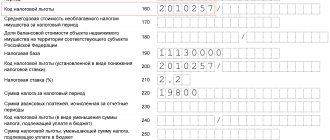New calculation procedure when changing land category
Significant amendments to land tax in 2021 were introduced into the Tax Code of the Russian Federation by Law No. 286-FZ of September 30, 2021. From January 1, 2021, when calculating land tax, the cadastral value is taken, which is determined on the date of registration of its change in the Unified State Register of Real Estate, which is maintained by Rosreestr. This new rule applies to those plots of land that have changed during the year:
- category;
- type of permitted use.
Taking into account the new procedure, the amount of tax is determined according to the ownership coefficient (Q). He is:
| Kv = Number of full months from the date of entering information about the cadastral value of land into the Unified State Register / Number of calendar months in the tax (reporting) period |
In general, the land tax base is determined for each plot according to its cadastral value exactly as of January 1 of the year. Its change during the year is not taken into account when determining the tax base in this and previous tax periods (clause 1 of Article 391 of the Tax Code of the Russian Federation). But this is a general rule.
But in practice, the current cadastral valuation may change due to a change in the type of permitted use of the land plot and/or its transfer from one category of land to another. Now this important factor is taken into account when calculating the tax from the day the updated information on the value of land is entered into the Unified State Register.
Note that until 2021, the absence of this exception led to the fact that changes in the value according to the cadastre could only be taken into account from the next tax period for land tax (letter of the Ministry of Finance of Russia dated April 14, 2017 No. 03-05-04-02/22593). Obviously, this was an unfair approach to both payers and the treasury.
What the land tax rate will be for 2021 is decided by local authorities. Therefore, you need to look at changes in the relevant law of the municipal territory.
Also see "Land tax: rate in 2021".
Land tax: advance payments, payment deadlines in 2018
The duration of the tax period for land tax corresponds to an annual interval. After each year, business entities must report to the tax authority on the calculation and payment of obligations, and repay the entire amount of accrued tax. Advances on land tax, payment deadlines in 2021 are regulated by regional authorities.
The size of advance transfers (if advances are established by local law) must be one quarter of the calculated annual tax liability. Payments are made on a quarterly basis. Full repayment of the entire tax amount occurs after the end of the reporting year: based on the results of the tax period, taking into account all advance payments, the taxpayer independently calculates the land tax. The payment deadlines in 2021 according to the Tax Code of the Russian Federation are set no later than February 1 of the year following the reporting year, unless the regional law establishes later deadlines. In the region where the land plot is located, where there is no requirement to make advance payments, the tax liability is paid immediately in one amount after the end of the tax period (Article 396 of the Tax Code of the Russian Federation).
New procedure for confirming the right to benefits
Also, changes in land tax from 2021 affected the procedure for declaring the right to a benefit (Law No. 286-FZ dated September 30, 2017, as amended by the Tax Code of the Russian Federation).
We can say that now it is not at all necessary to submit supporting documents to the Federal Tax Service to receive benefits. The fact is that from 01/01/2018, the order of the Federal Tax Service of Russia dated November 14, 2017 No. ММВ-7-21/897, which approved a new application form for the provision of benefits on three property taxes for individuals, comes into force. Including land tax:
Starting in 2021, this application form looks more like a tax return. In any case, the structure and filling principle have become similar.
In connection with the new application form, the payer of land tax from 2018 can choose from two options:
1. Submit to the Federal Tax Service the documents justifying the right to the benefit.
2. Just indicate the details of these documents.
In the second case, the tax authorities themselves will make a request to those bodies/organizations that issued the documents indicating the basis for the benefit specified in the application. And then the individual will receive a decision on the land tax for 2021 - whether they were given a benefit or not. If the Federal Tax Service does not receive such data, the payer will be informed of the need to submit supporting documents himself.
Thus, from 2021, the payer has the right to choose whether to submit documents to the Federal Tax Service for land benefits or not.
The payer will receive all information regarding the consideration of an application for a benefit through his personal account on the website of the Federal Tax Service of Russia. If one is not connected, you can choose the notification method:
- at the tax office;
- MFC (“My Documents”) through which the application was submitted;
- by mail.
You can apply for a land tax benefit to any Federal Tax Service Inspectorate, as well as through an individual’s personal account on the website of the Federal Tax Service of Russia.
Let us clarify the legal essence of the changes that have occurred. Some categories of individuals (including individual entrepreneurs) can reduce the tax base for land tax by a deduction of 10,000 rubles. This applies to land in ownership, permanent (perpetual) use or lifelong inheritable possession (clause 5 of Article 391 of the Tax Code of the Russian Federation). Until 2021, paragraph 6 of Art. 391 of the Tax Code of the Russian Federation established that a reduction in the taxable base is possible on the basis of supporting documents submitted to the Federal Tax Service. But from January 1, 2021, this rule is excluded from the Tax Code of the Russian Federation, since the new edition is set out in paragraph 10 of Art. 396 Tax Code of the Russian Federation. Moreover, the new procedure is extended to all land tax benefits for individuals, and not just in the form of a reduction in the tax base.
Also see “Main violations of land tax for 2021 based on the results of inspections.”
Land tax rate
The land tax rate is set by municipalities, but cannot be higher than the amount established by Art. 394 Tax Code of the Russian Federation. In particular, the maximum amount at 0.3% of the value of the land indicated in the cadastre is determined:
- for agricultural lands;
NOTE! Misuse of agricultural land will be reported to tax authorities. If this fact is established, the tax rate will increase to 1.5%. See here for details.
- lands under residential buildings and housing and communal infrastructure;
- lands allocated for gardens/vegetable gardens and subsidiary farming;
- special lands limited in circulation.
Read about the payment of land tax by residents of apartment buildings in our article “From January 1, 2015, owners of premises in apartment buildings will not pay land tax .
For all other land plots, the land tax rate in 2017-2018 cannot be higher than 1.5% of the value of the land in accordance with data from the state cadastre.
Land tax rates in 2017-2018 are established by the representative bodies of municipalities, and in cities of federal significance (Moscow, St. Petersburg and Sevastopol) by the representative bodies of the constituent entities of the Russian Federation in the relevant laws. Thus, the authorities may provide reduced rates for certain categories of land plots. For example, for plots occupied by technology parks or industrial parks in Moscow, the land tax rate is 0.7% (clause 1.6, article 3.1 of the Moscow city law “On land tax” dated November 24, 2004 No. 74). If in a municipality (or city of federal significance) special land tax rates are not established, then in accordance with clause 3 of Art. 394 of the Tax Code of the Russian Federation, the maximum rates determined by federal tax legislation apply.
The tax rate of land tax in 2017-2018 for legal entities is the same as for individual taxpayers. In the same way, legal entities-tenants or those to whom the land is transferred free of charge for use for a certain period are not considered taxpayers of land tax.
Management companies are recognized as payers of land tax on plots included in a mutual investment fund. In this situation, the tax is paid using funds from this investment fund.
New bans on tax exemptions
New paragraph 2 of Art. 395 of the Tax Code of the Russian Federation, which was introduced by Law No. 353-FZ of November 27, 2017, regulates the situation when, when dividing or merging land plots, tax exemption is not applicable to the resulting objects. This applies only to the following categories of payers:
- residents of a special economic zone (there will be no tax exemption for the first 5 years);
- shipbuilding enterprises are residents of the industrial and production SEZ (there will be no tax exemption for the first 10 years);
- participants of the free economic zone (there will be no tax exemption for the first 3 years).
The procedure for calculating land tax for legal entities
Enterprises calculate taxes themselves. In general, the formula for calculating land tax for legal entities looks like this:
N = KS1 × CH1 × KV1 + … + KSn × CHn × KVn,
Where:
N - land tax for the year;
KS1 ... KSn - cadastral value of each plot;
Сн1...Снn is the tax rate for each plot;
Kv1 ... Kvn is the coefficient of ownership of each plot.
The easiest and fastest way to find out the cadastral value is on the State Register of Real Estate website. In addition, you can contact the State Register in person and receive an official statement of the cost of the plot.
If the enterprise owned the land for a whole year, then the coefficient will be equal to 1. Otherwise, to determine it, the number of months of ownership should be divided by 12. Moreover, if the ownership right arose after the 15th day or was lost before the 15th day, then the month of occurrence ( loss) of rights is not taken into account.
The tax on plots located on the territory of several municipalities is calculated in proportion to the share of each municipality.
If local law requires quarterly advance payments, then their amount is 1/4 of the annual tax amount. That is, the procedure for calculating land tax is as follows:
Nav = N × ¼,
Where:
Nav - advance tax on land,
N - tax for the year
The final payment for the year is reduced by the amount of advances paid.
Organizations entitled to benefits adjust the formula given to take them into account. Local legislation may provide for tax exemptions for certain objects, tax deductions and other preferences, so it is impossible to develop a single formula suitable for everyone.
Let's look at how to calculate land tax using an example.
New declaration form is in effect
The innovation in land tax for legal entities from 2021 concerns the submission of a declaration for the period 2021 in a new form and format. They, as well as the procedure for filling them out, are now fixed by order of the Federal Tax Service dated May 10, 2021 No. ММВ-7-21/347.
The table below lists the main adjustments that have occurred in the land tax return form for legal entities since 2021:
| Declaration section | New declaration form | The previous form of the declaration (approved by order of the Federal Tax Service dated October 28, 2011 No. ММВ-7-11/696) |
| Title page | Removed the field for OKVED codes | There was a field for the OKVED code |
| Section 2 | Line 050 was supplemented with the indicator “Standard price of land” (filled out for plots in Crimea and Sevastopol) | Line 050 provides only the indicator “Cadastral value of a land plot” (it is not possible to indicate the standard price of land) |
The total number of lines is 25. The following lines are missing:
| Total number of lines – 28 |
You can check the correctness of filling out the land declaration in 2018 using special control ratios for it. They are confirmed by letter of the Federal Tax Service of Russia dated July 13, 2021 No. BS-4-21/13656.
Also see “What will change in 2021: taxes, insurance premiums, reporting, accounting and a new fee.”
Read also
26.12.2017
Filling out the declaration for 2018
We recommend filling out the declaration in the following sequence: first the title page, then section. 2 and finally section. 1.
Title page
In the “KPP” field, the code assigned during registration with the tax authority to which the declaration is submitted is indicated (clause 3.2.1 of the Procedure).
The field “at location (accounting) (code)” is filled out in accordance with Appendix No. 3 to the Procedure (clause 3.2.7 of the Procedure). For example, when submitting a calculation for the location of a land plot (share of a land plot), you need to indicate code “270” (Appendix No. 3 to the Procedure).
Section 2: calculation of land tax
Complete Section 2 for each site. In line 020, indicate OKTMO. You can find it on the Federal Tax Service website – https://nalog.ru/rn77/service/oktmo/.
Find the land category code for line 030 in Appendix No. 5 to the Procedure for filling out the declaration.
The category of land, its purpose and permitted use are indicated in the extract from the Unified State Register of Land Registers for the land plot, the certificate of ownership or the purchase and sale agreement. This information can also be found on the Rosreestr website using the cadastral number of the plot - https://rosreestr.ru/wps/portal/online_request.
In lines 050 and 110, indicate the cadastral value of the plot. If you are not the only owner of the plot, indicate the share of ownership in line 060, multiply lines 050 and 060, and show the result in line 110.
Take the cadastral value of the land as of January 1 of the year for which you are calculating the tax (clause 1 of Article 391 of the Tax Code of the Russian Federation). You can find it out by the cadastral number of the plot on the Rosreestr website https://rosreestr.ru/wps/portal/online_request.
The tax rate is reflected in line 120 (clause 5.14 of the Procedure).
The land tax rate is set by the local government. If he has not done this, the general rate applies - 1.5%, and for some categories of land, for example agricultural land - 0.3% (clause 3 of Article 394 of the Tax Code of the Russian Federation). The rate for your site can be clarified on the Federal Tax Service website - https://www.nalog.ru/rn77/service/tax/.
In lines 130 – 140, enter “12” and “1.0—“. If you did not own the plot for the entire year, indicate the full months of ownership and calculate the Kv Coefficient by dividing the number of months of ownership by 12. For example, if you owned the plot for 11 months, the Kv is equal to 0.9167 (11 months / 12 months) (Letter of the Federal Tax Service dated 06.04. 2018 No. BS-4-21/).
In line 150, indicate the tax amount - this is the product of lines 110, 120 and 140. Rewrite the amount from line 150 to line 250. In line 170, if there are no benefits, enter “1.0—“.
Fill in lines 070 – 100, 160, 180 – 245 only if you are using benefits. If not, put dashes.
Federal benefits are established in Art. 395 Tax Code of the Russian Federation. You can check whether there are benefits at the local level on the Federal Tax Service website - https://www.nalog.ru/rn77/service/tax/ (clause 2 of Article 387 of the Tax Code of the Russian Federation). Land tax benefit codes for filling out the declaration are given in Appendix 6 to the Procedure for filling it out.
Example of calculating land tax
The organization owns a site for long-term storage of cars with a cadastral value of 64,105,865 rubles.
- Tax rate – 0.1%.
- The calculated tax amount for the year is RUB 64,106. (RUB 64,105,865 x 0.1%).
- Advance payments for the 1st, 2nd and 3rd quarters – 16,027 rubles each. (RUB 64,106 / 4).
- Tax payable at the end of the year – 16,025 rubles. (RUB 64,106 – (RUB 16,027 x 3)).
Section 1: land tax amount
Section 1 is completed for all land plots that are objects of taxation (clause 4.1 of the Procedure). It reflects the amount of tax calculated at the end of the year (including advance payments for reporting periods). In this case, for each OKTMO you need to fill out lines 010 – 040 separately.
When filling out line 021, you should add up the tax amounts indicated in line 250 of all sections. 2, which have one OKTMO and BSC (clause 3, clause 4.2 of the Procedure).
Lines 023, 025 and 027 reflect the amounts of advance payments payable to the budget for the 1st, 2nd and 3rd quarters, respectively (clause 4, clause 4.2 of the Procedure).
Let's look at a sample of filling out a land tax return for 2018.
Example:
- the organization is registered for tax purposes at its location with the Federal Tax Service of Russia No. 27 in Moscow (tax authority code - 7727);
- TIN 7727098760/KPP 772701001;
- the organization owns one land plot (OKTMO code – 45908000);
- the period of ownership of the land plot in 2021 is 12 months;
- the cadastral value of the land plot as of January 1, 2021 was 58,000,000 rubles;
- On November 1, 2021, information about changes in the cadastral value of the land plot was entered into the Unified State Register of Real Estate due to a change in the area of the plot - the cadastral value was RUB 57,500,000;
- The cadastral number of the plot before the change in cadastral value is 77:06:0004005:71. From November 1, 2021, the cadastral number of the plot is 77:06:0004005:77;
- land tax rate - 1.5% of the cadastral value of the site (clause 4, part 1, article 2 of the Moscow Law of November 24, 2004 N 74);
- the organization has no grounds for applying tax benefits;
- during the tax period, the organization pays advance payments for land tax (clause 2 of article 397 of the Tax Code of the Russian Federation, part 2 of article 3 of the Moscow Law of November 24, 2004 No. 74).










